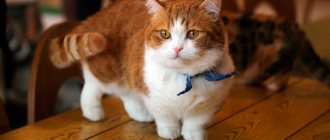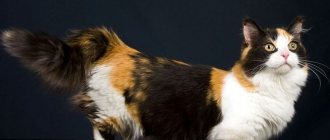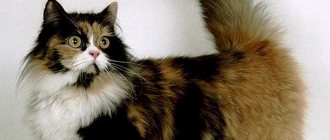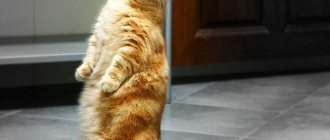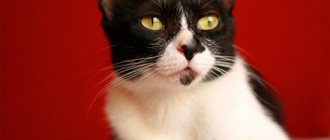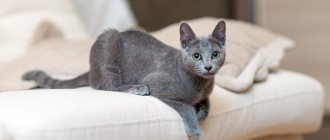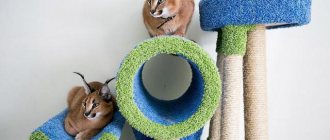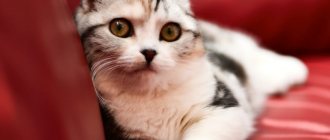The Munchkin cat breed is one of the most amazing and cutest. Short-legged cats, wrapped in soft thick fur, with a childish expression on their faces, have acquired fans all over the world. Their origin was made possible by mutation, but one should not think that the animals suffer from such an original gift of nature: this did not affect their agility, character and health in any way. It is worth learning the history of the appearance of chic fluffy dachshund cats in the world and their habits: this animal is worthy of attention.
The history of munchkins
Munchkins are charming short-legged cats.
In the 30s of the twentieth century, references to unusual short-legged cats periodically appeared in Europe. The Second World War, which soon broke out, almost completely erased this genetic line. In 1944, one of the British veterinarians reported observations of several generations of cats that were similar to ordinary domestic cats except for the parameters of the limbs. After the war, such animals were seen in the USA and USSR. In 1953, Soviet sources dubbed them "Stalingrad kangaroos", suggesting that the mutation occurred due to existence in harsh conditions.
The modern round of development of the Munchkin breed occurred in 1983, when teacher Sandra Hochenedel from Louisiana, returning home, noticed an unusual pregnant cat. The woman took pity on her and took her in, giving her the nickname Blackberry. Half of the kittens that were born also had short legs, which surprised Sandra. She decided to give an unusual pet to her friend Kay LaFrance. This is how the Blackbury and Toulouse cats became the ancestors of the modern breed.
Sandra and Kay managed to interest Dr. Solveig Pflueger, who served as a TICA judge, about munchkins. He examined the unusual cats and made an unequivocal verdict - the breed appeared naturally, thanks to changes in the recessive gene that regulates the length of the paws. Unlike dachshunds and other short animals, munchkins' short legs usually do not lead to back problems.
Munchkin kitten
The general public first learned about the breed at the TICA national show held at Madison Square Garden in 1991. Most viewers and experts were critical of the viability of munchkins, branding them living evidence of violations of the breeders' ethics. Despite lengthy disputes, by 1994 TICA managed to list the breed as developing. In the early 2000s, munchkins won the championship title and gained real popularity.
The breed is recognized by the associations TICA, AACE, UFO, SACC and WNCA. The FIF, CFA and Governing Council of the Cat Fancy societies refused to register munchkins, considering these cats to be genetically inferior. TICA resolved the issue democratically - only cats whose owners are able to confirm a monobreed pedigree in three or more generations are allowed to participate in the show. Munchkins got their unusual name in honor of the cheerful, friendly people from the book “The Wonderful Wizard of Oz.”
History of the origin of the breed
Munchkins were born as a result of random mutation processes, so the appearance of this breed has nothing to do with the efforts of breeders. This happened somewhere at the beginning of the last century.
Interesting to know! The peculiarity of this animal is associated with its original appearance, due to the presence of the achondroplasin gene in the Munchkin genes.
After the appearance of this breed, the whole of Europe vigorously discussed this fact, indicating the appearance of an unusual cat with very short limbs. The breed appeared on our territory not so long ago, about a decade and a half ago, but managed to gain the trust of many breeders.
Munchkin appearance
Munchkin
Munchkins are unique and cannot be confused with other cats due to their greatly shortened paws. With an average body size, the legs of these cats are 2-3 times smaller than those of other breeds. Despite this mutation, munchkins have retained a healthy spine, so they have a mobile, flexible, strong body. The average weight of cats ranges from 2.2 to 4 kilograms.
Munchkins are often crossed with other breeds, so they can differ in appearance and personality. The offspring are often long-legged. Such cats do not participate in shows, but can be used for the development of the breed, since the presence of two short-legged parents increases the mortality rate of kittens in the litter. Breeders are actively developing munchkins, so associations have not yet introduced strict standards.
Head
Proportional to the size of the body, has rounded contours, the shape of a modified wedge. The cheekbones are high and are usually more pronounced in cats than in cats. The muzzle is of medium length, the transition of the nose to the forehead is smooth. Some deflection of the bridge of the nose is allowed. The chin is small and firm.
Eyes
Munchkin looks out the window
Almond-shaped, medium to large in size. The rather wide set at a slight angle provides an open expression to the muzzle. Munchkins do not have a strict connection between eye color and coat color.
Ears
The ears are wide at the base and rounded at the tips. Sinks can be medium or large in size, located wide and high. The presence of tassels is permissible only in representatives of the breed with long hair.
Neck
Cats have larger, more muscular, dense necks than cats.
Body
The Munchkin's body is elongated and cannot be called compact. The back has a slight downward slope from the tail to the shoulders. The hips are firm, the chest is rounded. The bones are of medium size, the muscles are well developed. Males are usually larger than cats. Angled blades are allowed.
Munchkin and his toys
Legs
The limbs are short, located at the same distance in the direction of view from head to tail. The upper and lower parts of the front legs, as well as the thighs and lower parts of the hind legs, are equal in length. The hind limbs are often slightly longer than the forelimbs. Munchkins have three legs: regular, short, and very short (Rug hugger).
Paws
Red munchkin kitten
The Munchkin's paws are proportional to the body and have a rounded shape. Curvature outward or inward is not allowed.
Tail
The length of the tail and body is usually the same. The thickness is average, there is a rounded, somewhat narrowed tip. During movement, the tail comes to a vertical position. If there is long hair, this part of the body receives an abundant plume.
Wool
The coat is silky semi-long or velvety short, with medium undercoat.
Colors
Munchkins can have any coat color; bicolored individuals are often found.
Lifespan
Munchkins live 12-13 years, but with professional care they can live up to 16-20 years.
Possible disadvantages
Too short or long nose, protruding chest bone, round head and eyes, cow-type paws, stocky short body, curly hair.
Disqualification criteria
Deafness, amputated claws, cryptorchidism.
Disqualifying defects for exhibition
The presence of characteristic features of other breeds, saggy croup, excessively concave back.
Buy a munchkin
As noted above, cats of this breed appeared with us not so long ago. Despite this, this breed is bred by many experienced breeders, as well as nurseries, so purchasing a kitten of this breed is not associated with difficulties.
What to pay attention to
Purchasing a kitten is associated with a number of features. Particular attention should be paid to visual inspection of the animal, as well as the parent pair. It is better to observe for some time the behavior of the animal, clarifying some points:
- Age of the parent couple.
- The number of their matings.
- The presence of diseases they have suffered.
- Presence of hereditary diseases.
- Difficulty of pregnancy and childbirth.
- Presence of kittens with extra toes in the litter.
- Availability of vaccinations, as well as deworming procedures.
- Carrying out activities for sterilization or castration of kittens.
- The behavior of the parent couple.
- Method of feeding kittens.
- Features of keeping cats of this breed at home.
When purchasing a kitten from a responsible breeder or nursery, a potential client has the right to receive information regarding raising a munchkin at home. It would be useful to remind you that the kitten must be accompanied by all the necessary documents indicating its pedigree origin.
Munchkin kitten price
A kitten of 3 months of age with confirmation of purebred, but without accompanying documents, can cost a maximum of 6 thousand rubles. If the kitten has a package of relevant documents, then you will have to pay 2 times more for it. The cost of kittens sold in nurseries of the highest level is set on the basis of a special expert commission.
Photos of munchkins
Breeding
An unusual fact in the development of long-haired and short-haired forms of the breed is crossing with outbred cats . As a result, the solid color is less common compared to the tabi color.
When munchkins mate with each other, all kittens have short legs. But in the first generation, when munchkins mate with ordinary cats, there are no results.
Until recently, it was difficult to purchase a munchkin kitten in Russia. Today you can buy a purebred pet from a breeder in almost every major city in the country.
Thus, there are several nurseries in Moscow, the largest of which are Sunny Fairies and Murmulet; you can also apply for a kitten at Super Munchkin, which is located in St. Petersburg.
In addition, kittens with a pedigree are sold in the Iberis nursery in the city of Magnitogorsk and in similar organizations in Tyumen, Kaliningrad, and Yekaterinburg. Due to the fact that kittens sell out quickly, the animal can be reserved in advance.
Kittens from nurseries are sold only after castration or sterilization, in order to prevent mating with other animals, as this is harmful to the development of the breed.
If the presence of a pedigree is not important for future offspring, then a mating partner is found from among ordinary cat owners. It is important that the partner does not have the dominant gene responsible for the appearance of short legs.
Munchkin character
Munchkin on his hind legs
Munchkin looks at life realistically and does not complain about its trials, is confident in himself and his abilities, good-natured, and curious. People see these cats as slightly out of this world. It cannot be said that the character of munchkins is approximately the same, it depends on genes, so their types of behavior are different. But in general, these are lively animals with great sympathy for people.
Representatives of the breed love outdoor games; the short legs of munchkins do not prevent them from being quite nimble: they very quickly jump on low tables, chairs, and other furniture. And the owners’ favorite curtains are also easily attacked by them. Of course, they won’t be able to jump too high, but stealing something tasty from the kitchen table after first jumping on, for example, a stool is a piece of cake for them.
Munchkins are smart, very friendly, clean animals that quickly get used to new surroundings and people. They remain playful throughout their lives and are especially fond of children. Munchkins are extremely inquisitive, often “borrowing” and hiding small things to play with in moments of loneliness, so it is better to hide all valuable, fragile trinkets away. It is advisable to periodically look for such “treasuries”, since missing keys, socks, and pencils are usually found there.
Munchkins are distinguished by truly canine devotion to their owner, but they have their own character and are able to stand up for themselves. These cats easily tolerate travel and do not resist walks on a harness. An interesting feature of the breed is the ability to sit on its hind legs for a long time, surveying the surroundings. At the same time, the front legs hang funny along the body, which is why munchkins are often called “kangaroo cats.”
Character traits
The short-legged Munchkin cat has a friendly disposition and always finds a common language with other pets: the cat’s dogs will not see her as a rival.
The pet respects its owners and easily adapts to the mood. Strangers also quickly establish contact with the kitten after seeing its feline charm and kindness.
Walking around the room, they stomp their feet like hedgehogs, which also lifts the mood. The cheerful, playful, easy-going nature of the munchkin will not leave anyone indifferent.
These cats are curious and friendly, love to play and easily tolerate the “squeezing” of children, do not show aggression towards other pets, but can catch smaller animals: birds and rodents.
The presented description of the breed shows that understated Munchkin cats can easily make friends not only with an adult owner, but also with a child.
Care and maintenance
Who is the most curious cat?
This breed is easy to maintain and does not require special care. Experts recommend following a few simple rules.
- Despite the sociable nature of cats, they love to “build nests” in order to feel protected while resting. Provide the munchkin with a basket, small sturdy box, or other house with soft bedding.
- Buy a deep tray, since clean pets actively bury waste and can litter around.
- It is enough to comb short-haired munchkins once a week, and 2 times a week for long-haired munchkins. The main thing is to prevent tangles from occurring.
- It is enough to bathe these cats once every 3-4 months with special shampoos.
- Changing claws is usually easy for munchkins, especially if there is a scratching post in the house. Once every 2-3 weeks it is worth checking the condition of the paws in order to help the pet if necessary.
- You should clean your ears not deeply and very carefully, about once a month.
- It is not advisable to let cats go for walks on their own, as a squat animal often looks like it is preparing to attack, which may be misunderstood by other pets or people. Due to the short legs, the munchkin can be injured.
- Munchkins should be fed in moderation because, despite their high mobility, they are prone to obesity. Provide frequent replacement of drinking water and adequate nutrition.
- By using special toothpastes once a month, you can successfully prevent the development of oral diseases in munchkins.
Om-Nom-nom
As for food, it is not recommended to feed your cat from a common table. Use specialized or separately prepared natural foods. These types of food should be alternated, but not mixed in one plate. Do not buy cheap food as it is similar to fast food for humans. Are you planning to cook food for your munchkin at home? Experts advise preparing your diet this way:
- 60% – raw or boiled meat (rabbit, beef, offal);
- 30% – boiled or raw vegetables;
- 10% – porridge.
Munchkins should not be treated to salty, sweet, fried, smoked, bean dishes, fish, or fatty meats (lamb, pork). An adult cat can be fed a couple of times a day, kittens - up to 6 times a day.
Conclusions about the munchkin cat breed
The original and funny munchkin cat breed is becoming more popular all over the world for many reasons:
- the touching expression of the face and the small size of the cat evoke a desire to take care of such a treasure;
- short legs do not make the animal clumsy; on the contrary, agility and speed of movement will be the main characteristics of mobility;
- numerous color variations will suit every taste;
- the kangaroo cat is very playful and loves to take part in outdoor games;
- a peaceful disposition will be appreciated by people with small children in the house;
- not a loud animal at all: no annoying meows at night;
- The health of a purebred kitten and care for it guarantee the absence of serious problems in the future.
The owners of these animals can be considered happy people.
Munchkin health
Two Friends
The Munchkin is a young breed with an actively expanding gene pool, so its representatives rarely suffer from congenital diseases and have good immunity. Owners should know that such cats have some intolerance to plant foods, so their share in the diet should be small. Sometimes there are cases of congenital lordosis - excessive deflection of the spine in the area of the shoulder blades.
Munchkins may suffer from lordosis. This is a disease in which the muscles that support the spinal column are weakened and it moves into the chest cavity, putting pressure on the heart and lungs. A slight curvature will not cause problems, but it can be aggravated by previous injuries and obesity. Severe lordosis causes difficulty breathing and increases stress on the heart muscle, which can lead to illness. However, lordosis is a fairly rare disease. By the way, other cat breeds can also suffer from it.
Since the munchkin's short paws are a consequence of a natural genetic mutation, some kittens may have short paws, while others may have normal or long paws. If the gene responsible for short limbs is passed on to an embryo from both parents, it can be fatal.
History of the Munchkin breed
global $ads_google;
//data-ad-slot=”2475549904″ $ads_google = empty($ads_google) ? false : true; ?> if ($ads_google == false) {?> $ads_google = true; ?> } ?> The Munchkin cat is American by origin. And he could well be Russian - during the Second World War, kangaroo cats roamed Stalingrad. Their body structure was reminiscent of Australian animals with long hind limbs and greatly shortened front legs. When such a cat sat on its hind legs, in appearance it became very similar to a kangaroo. But the ancestor of the current purebred short-legged cat was the black and white cat Bramble from Louisiana (USA). So, in 1983, the history of a new amazing breed of funny cats began.
Ezhevichka had a peculiarity - very short legs, and the owner, Sandra Hochenedel, who picked up this pregnant cat from the street, considered this sign a consequence of the disease. The kittens that appeared caused even more surprise; they were a copy of their mother. A wonderful baby named Toulouse was given to Sandra's friend Kay LaFrance. Toulouse also gave the world many of its short-legged descendants.
The new breed was officially demonstrated at the TICA show in the spring of 1991. Subsequent study of the characteristics of animals revealed that short legs are a natural mutation and do not complicate the life of cats in any way. Further crossbreeding gave rise to many varieties of munchkin appearance, but the characteristics of the breed are still being improved.
How to choose a kitten
The rules for selecting munchkin kittens are standard: take active, clean babies aged 12 weeks or older with the necessary vaccinations. Contact only reputable kennels that offer registered animals. This will allow you to purchase a truly healthy kitten, without serious congenital defects. Munchkins have won the love of a wide audience, so real queues often line up for them. If you don’t care about a certain gender, color type, or coat length, you can get a kitten fairly quickly. You should not buy munchkins at bird markets or through private advertisements, tempted by the low price. This can result in long-term treatment of the animal or the acquisition of a non-viable individual.
Breed card
| Characteristics of a cat | Notes | |
| General information | Characteristic looking cat, great companion | |
| Character | Friendly, calm cat | |
| Appearance | Short-legged cats are otherwise similar to regular domestic cats. | Comes from an ordinary street cat |
| Behavior at home | Affectionate, moderately active, can run quickly if necessary | Jumping on short legs is quite difficult, so that your things lying on the shelves will remain intact |
| Care | Just like any other cat. Longhaired Munchkins have a silky coat, making them easier to care for than many other longhaired breeds. | Shorthaired Munchkins require less maintenance when it comes to grooming. |
| Health problems | No special health problems noted | Fears that munchkins, like dachshunds, may suffer from spinal problems have not been confirmed |
Photos of munchkin kittens
Habits and disposition
Breeders of short-legged pets note their friendly nature. Cats are incredibly playful, and an anomaly with paws is not a hindrance to racing and fun. Loyalty to the owner is like that of a dog. Cats, like true companions, follow their human step by step.
It is believed that people with a gloomy and negative character are not recommended to have such pets, since munchkins persistently demand attention, call for play, and can pester the owner for several hours in a row. To withstand such persistence, you need to have angelic patience and truly love your pet.
Munchkins cannot be called “couch cushions”; they are quite active, but if the situation requires they can show patience and humility. For example, when it comes to small children. Cats of this color are ideal for families with children. They allow you to play with them, carry them, cuddle them, and will never offend their little owners. But if they go too far and create a threat to health and life, then the munchkin will have to defend himself and let out his claws.
Cats are not shy, they are moderately curious. The reaction to a new person in the house is not fear, but a desire to get to know each other as soon as possible. The pet will definitely come up to take a good look at the stranger and offer its back for stroking. The same reaction to the new premises. Munchkin is an inquisitive explorer who will explore a new space step by step, looking into every corner, even the one that seems impossible to penetrate.
Due to their sociability, pets do not tolerate loneliness well. They can get used to daily separation from their owner, but when they meet, they will definitely sit on his lap and purr peacefully for at least an hour. After a couple of years of living with the owner, the animal gets so used to him that he follows him like a dog. They are sometimes called dachshund cats. During the warm season, you can see pets being walked on a leash, and they are happy to explore the area.
Care
Cats are very clean, and the munchkin is even more so. From infancy, they quickly get used to the tray and do not allow incidents. They always eat carefully, without splashing or scattering food.
Cats' fur is thick and dense; it must be combed with a special brush and washed twice a year. The washing procedure should be carried out in spring and autumn, be sure to use a special shampoo. Pets are extremely aggressive when it comes to washing, they break out and scratch. You should prepare in advance, stock up on a hat and other accessories that are sold in pet stores.
There should be several scratching posts in the house where a munchkin lives. Exclusively for the safety of wallpaper and property, because cats are very active.
Nutrition
The pet can be fed with store-bought food or what the owner prepares for him himself. If the second food option is chosen, then you need to choose quality products. For example, fatty pork is absolutely not suitable. Beef and veal must be thoroughly boiled, and all bones must be removed from poultry meat.
A cat's diet should contain up to 60% meat, the remaining 40% should be filled with vegetables. Vegetables are given to the cat raw and boiled. Food should not be salted, sweetened, or improved in taste with seasonings. The volume of fatty ingredients must be reduced to a minimum, since munchkins are prone to obesity.
Prohibited Products
– lamb, all cereals, all legumes, fatty meat. Also, dishes from the owner's table are not suitable for feeding cats. It can be difficult to refuse a pet who funny stands upright, folding his short legs on his chest, and begs for a tasty morsel. But you should understand that such food is harmful to your pet. In addition to obesity, it can cause problems with the digestive system, liver, and heart. Experienced breeders warn beginners who get cats of any breed about the importance of proper nutrition for their pets.
If your pet eats artificial, store-bought food, then it is important to choose premium products. They contain a balanced amount of vitamins, minerals and other substances necessary for cat health.
Health munchkin
Representatives of the suit are awarded by nature with good health and strong immunity, apparently as compensation for the mutation. However, it is the gene for short legs that causes inconvenience to cats in the form of spinal lordosis disease. Over the course of a pet's life, the muscles in the chest weaken and gradually atrophy completely. Because of this problem, the cat has difficulty moving and has problems with the respiratory and cardiac systems.
To maintain health, it is important to vaccinate your cat periodically. Owners often walk their pets outside, where they can be exposed to many viruses and bacteria. Traditionally, vaccinations are given once a year.
If your pet is sick, you should not self-medicate. This rule applies to any living creature. Only a doctor can examine and prescribe proper treatment.
When choosing a munchkin cat as a pet, you need to soberly evaluate its characteristics. She has a friendly character, is relatively unpretentious in nutrition, and has a strong immune system. However, the cat requires special care due to its anomaly; sooner or later it will develop health problems that cannot be ignored. The well-being and longevity of a cat are entirely in the hands of the owner. Is he ready to take on such responsibility? Munchkins are very smart, loyal, they are sincerely grateful to their owner for his care and attention.
How much does a munchkin cost?
The price of a Munchkin kitten in Russia ranges from 3 to 40 thousand rubles, depending on gender, color, coat length, and the specific breeder. It is customary to cross Munchkins only with healthy domestic cats of similar appearance or with each other. Hybrid kittens that have inherited characteristics of other breeds are not allowed to show and are therefore sold at a reduced price. They do not differ in character from their counterparts and sometimes look nicer than the show ones. Also, healthy pets with other appearance features that cause disqualification from competitions will cost less. This is a great opportunity to acquire a loyal four-legged friend inexpensively.
Cat sizes and weights
The Munchkin cat with short legs is not large in size. Body length is average. The height of the animals' withers is approximately 15 cm. Kittens quickly increase in size.
Weight depends on gender. The weight of a cat is 3-4 kg, a female cat is 2-4 kg. The size of munchkins also depends on the species. There are cats that are larger than the standard parameters, and there are cats that are smaller.
A Munchkin cat with short legs is not large in size/Yandex Collections
